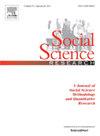房子的钥匙——财富转移如何使房屋所有权机会分层
IF 3.5
2区 社会学
Q1 SOCIOLOGY
引用次数: 0
摘要
本研究调查了实际的和预期的代际财富转移——即,在世间的礼物和遗产——如何导致父母社会阶层向住房所有权过渡的不平等。利用对德国社会经济小组研究(N = 13,018)数据的离散时间生存分析,我们发现父母是体力劳动者或服务工作者的个体比父母属于其他社会阶层的个体更不可能成为房主。接受遗产或生前赠与大大增加了拥有住房的可能性,这种影响在转让年度最为明显,此后迅速消退。预期的未来转让也增加了在转让收到之前拥有住房的可能性。预期和收到的转移合计占父母社会阶层住房所有权转换率差异的15 - 54%。忽视预期的转移会导致严重低估财富在塑造父母阶层和房屋所有权之间关系中的作用。然而,对于大多数阶级差异,其他中介因素——如受访者的社会阶层、收入和家庭地位——比财富转移更能解释差异。本文章由计算机程序翻译,如有差异,请以英文原文为准。
The keys to the house - How wealth transfers stratify homeownership opportunities
This study investigates how actual and anticipated intergenerational wealth transfers – i.e., inter vivos gifts and inheritances – contribute to inequalities in the transition to homeownership by parental social class. Utilizing discrete-time survival analysis on data from the German Socioeconomic Panel Study (N = 13,018), we find that individuals whose parents were manual workers or service workers are less likely to become homeowners than those whose parents belonged to other social classes. Receiving inheritances or inter vivos gifts substantially increases the probability of homeownership, with the effect being most pronounced in the transfer year and diminishing rapidly thereafter. Anticipated future transfers also increase homeownership probability before transfer receipt. Together, anticipated and received transfers account for 15–54 % of the differences in homeownership transition rates by parental social class. Ignoring expected transfers leads to a significant underestimation of the role that wealth plays in shaping the relationship between parental class and homeownership. However, for most class contrasts, other mediators— such as respondents’ social class, income, and family status— explain a larger share of the differences than wealth transfers.
求助全文
通过发布文献求助,成功后即可免费获取论文全文。
去求助
来源期刊

Social Science Research
SOCIOLOGY-
CiteScore
4.30
自引率
4.00%
发文量
0
审稿时长
65 days
期刊介绍:
Social Science Research publishes papers devoted to quantitative social science research and methodology. The journal features articles that illustrate the use of quantitative methods in the empirical solution of substantive problems, and emphasizes those concerned with issues or methods that cut across traditional disciplinary lines. Special attention is given to methods that have been used by only one particular social science discipline, but that may have application to a broader range of areas.
 求助内容:
求助内容: 应助结果提醒方式:
应助结果提醒方式:


